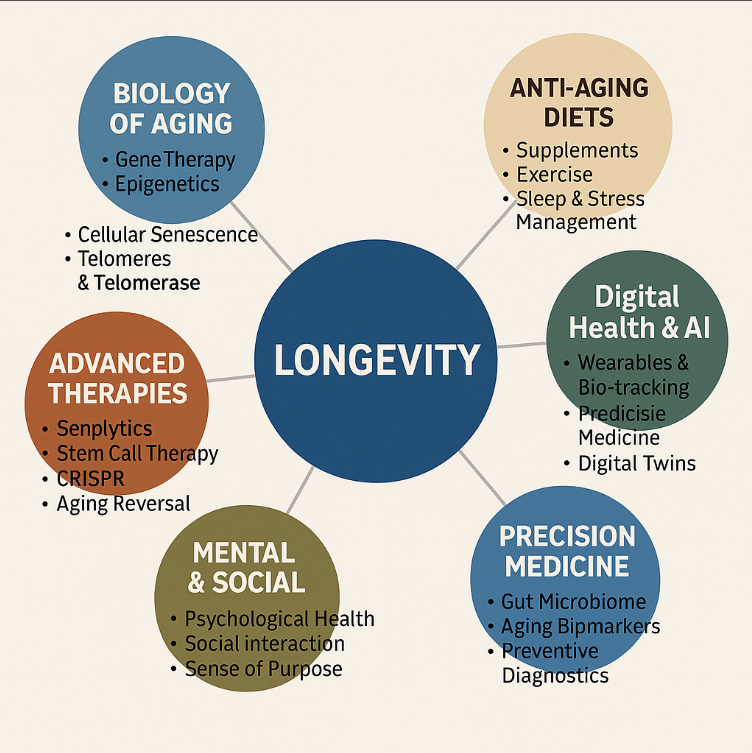Last Updated on 2025-06-25
As global life expectancy increases, the focus has shifted from simply living longer to living better. This shift has birthed a massive new opportunity: the longevity economy.
Whether it’s through gene therapy, personalized diets, or AI-powered wearables, the future of aging is being rewritten by science, technology, and wellness. In this post, we explore the six key longevity sectors — now sorted by their projected market size by 2030, to help you understand where the biggest opportunities lie.
Longevity Market Share by 2030 (TAM – Total Addressable Market)
1. Precision & Preventive Medicine
Estimated TAM (2030): $314.0B
The largest and fastest-growing segment uses genetic, microbiome, and lifestyle data to create proactive, personalized health plans.
Key Areas:
1. Gut microbiome testing (Viome, ZOE)
2. Genetic sequencing and risk profiling
3. Blood biomarker tracking
Common Longevity Biomarkers:
| Biomarker | Purpose/Insight |
|---|---|
| CRP | Chronic inflammation, aging acceleration |
| Glucose & HbA1c | Blood sugar control, diabetes risk |
| Cholesterol (LDL/HDL) | Heart health, stroke risk |
| Triglycerides | Fat metabolism, linked to fatty liver |
| Vitamin D | Bone health, immune function, and mood |
| Hormones (Testosterone/Estrogen) | Vitality, mood, aging rate |
| ALT / AST | Liver function |
| Creatinine | Kidney function |
4. Personalized supplement regimens
5. Disease prediction & prevention algorithms
6. Medicine-as-a-service platforms
2. Lifestyle & Nutrition
Estimated TAM (2030): $247.9B
Driven by consumer demand for daily, proactive wellness strategies that extend lifespan and healthspan.
Key Areas:
1. Intermittent fasting & calorie restriction
2. Longevity-focused diets (Blue Zones, Mediterranean)
Longevity-Focused Diets: Blue Zones & Mediterranean Explained
Not all diets are created equal when it comes to extending lifespan. Two of the most studied and praised longevity-oriented diets are:
Blue Zones Diet
Based on regions worldwide where people live significantly longer lives, often surpassing age 90 or even 100. These zones include Sardinia (Italy), Okinawa (Japan), Nicoya (Costa Rica), Icaria (Greece), and Loma Linda (California).
Common traits of Blue Zones diets:
-
90–95% plant-based (low animal protein)
-
High consumption of beans, lentils, and legumes
-
Minimal processed food and sugar
-
Eat meat only 1–2 times per week
-
Whole grains and sourdough bread
-
Daily intake of nuts
-
Wine in moderation (mostly red)
-
Light dinners and smaller portion sizes
Mediterranean Diet
Inspired by the traditional diets of countries like Greece, Italy, and Spain.
Core principles:
-
Healthy fats: primarily olive oil
-
Protein: more fish and poultry, less red meat
-
Lots of vegetables and fruits
-
Whole grains (brown rice, bulgur, oats)
-
Moderate dairy (mostly yogurt and cheese)
-
Natural herbs and spices
-
Wine in moderation
-
Low sugar intake
These diets are scientifically linked to lower rates of heart disease, obesity, diabetes, and even neurodegenerative conditions — all contributing to longer and healthier lives.
3. Anti-aging supplements (NMN, Spermidine, Resveratrol)
4. Holistic nutrition plans & coaching
5. Stress, sleep & lifestyle optimization
6. Personalized food & meal tracking
In this Segment of longevity, UPDiet is shining.
3. Digital Health & AI
Estimated TAM (2030): $63.0B
Where tech meets health, wearables, sensors, and AI enable real-time health optimization like never before.
Key Areas:
- Smart wearables (Oura Ring, WHOOP, Apple Watch)
- Health data platforms & dashboards
- AI for predictive diagnostics
- Digital twins and simulations
- Real-time bio-tracking & behavior nudging
- Health gamification apps
4. Biology of Aging
Estimated TAM (2030): $4.1B
This scientific core of longevity research explores what aging truly is — and how we might slow, stop, or even reverse it.
Key Areas:
- Cellular senescence
- Telomere & telomerase dynamics
- DNA damage repair
- Epigenetic reprogramming
- Genetic therapies targeting aging at the root
- Longevity-focused biotech research
5. Advanced Therapies
Estimated TAM (2030): $4.1B
High-risk, high-reward innovations aiming to restore or regenerate the body at a cellular level.
Key Areas:
- Senolytic drugs (clearance of old cells)
- Stem cell therapy
- CRISPR & gene editing
- Cellular reprogramming (Yamanaka factors)
- Plasma exchange and rejuvenation research
- Reversal of age-related disease
6. Mental & Social Longevity
Estimated TAM (2030): $3.9B
True longevity isn’t just physical. Cognitive vitality, emotional well-being, and meaningful social bonds are key to aging well.
Key Areas:
- Emotional health & resilience
- Cognitive enhancement tools
- AI-powered companionship (e.g., Replika)
- Social platforms for senior inclusion
- Purpose-driven coaching for aging adults
- Longevity psychology & mindset training
Comparative Table: Market Size by 2030
| Rank | Pillar | Estimated TAM (2030) |
|---|---|---|
| 1️⃣ | Precision & Preventive Medicine | $314.0B |
| 2️⃣ | Lifestyle & Nutrition | $247.9B |
| 3️⃣ | Digital Health & AI | $63.0B |
| 4️⃣ | Biology of Aging | $4.1B |
| 5️⃣ | Advanced Therapies | $4.1B |
| 6️⃣ | Mental & Social Longevity | $3.9B |
Final Thought
From trillion-dollar lifestyle sectors to billion-dollar biotech moonshots, the longevity industry is among the most exciting frontiers for entrepreneurs, researchers, and investors. As aging transforms into a solvable problem, now is the time to build for the 100-year life.
UpDiet is building the bridge between lifestyle optimization and precision medicine — a platform at the intersection of personalized nutrition, AI, and preventative health. While most wellness apps stop at generic advice, UpDiet integrates biological signals (like blood tests, DNA, and microbiome data) with real-time lifestyle inputs to deliver ultra-personalized meal plans and longevity coaching. Positioned across the fastest-growing sectors of the longevity economy — Lifestyle & Nutrition, Digital Health, and Precision Medicine — UpDiet is more than a diet app. It’s a Longevity OS for the 100-year life.

